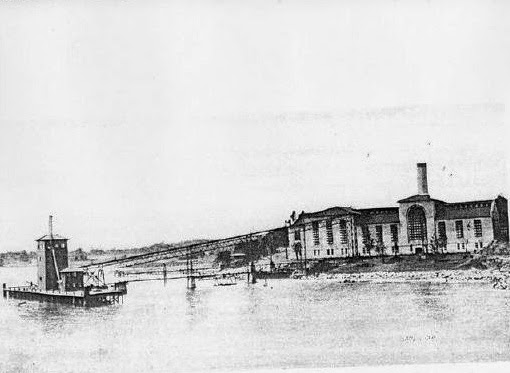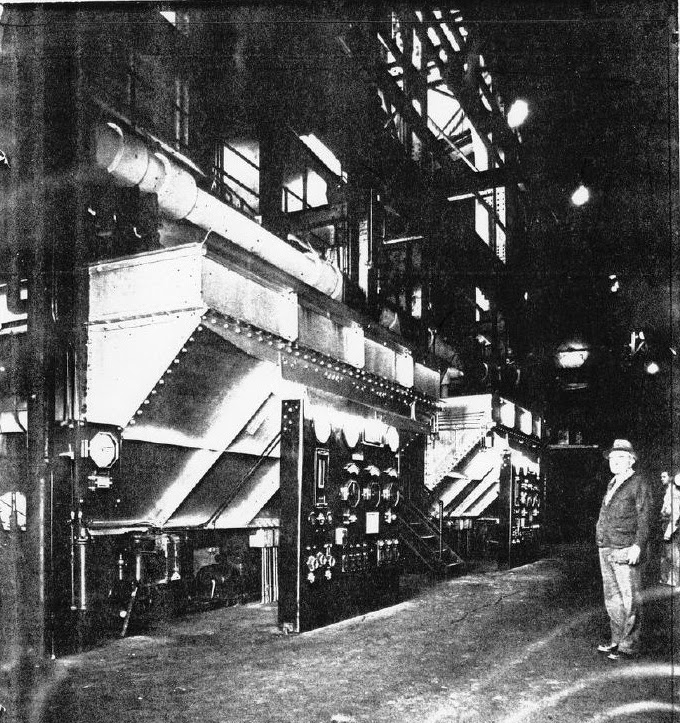Today, plans are underway to
celebrate the opening of the new Cos Cob Park. Near the beginning of the last
century, in 1907, a very different opening was in the works on those very
grounds. That is the year the Cos Cob Power Plant opened its mighty doors, and
one man who had been there since the beginning was destined to become the
plant’s chief electrical engineer.
 |
| The Cos Cob Power Plant, 1907 |
 |
| Lewis Grant O'Donnell |
In an Oral History Project
interview conducted in 1989 long-time Cos Cob resident, Gertrude O’Donnell
Riska, remembers this man, her father, Lewis Grant O’Donnell, who maintained
overall responsibility for the plant from 1923 until his retirement in 1940.
 |
| Gertrude O'Donnell Riska |
When Ms. Riska quotes her
father in her interview, she tends to get her reader’s attention:
“My father would scare me to
death. At different times he’d say to me, ‘See that turbine over there? There’s
a big wheel inside it. If that wheel ever broke loose—and it has in other power
plants—it would cut a path of destruction for ten miles…’”
The turbine she is
describing was one of half a dozen or more, each as big as a house, and between
them were generators weighing fifty tons each. The turbines made the steam that
went into the generators that made the electricity. The turbines and generators
were like “soldiers down a huge hall” and they were “bigger than houses,”
located in bedrock four stories down with support pillars six feet thick. Her
primary impression inside the plant was of heat and noise.
Ms. Riska describes the
plant, owned by what was then the New York, New Haven, and Hartford Railroad
Company, as the first to use alternating current electrification to run the
trains, a claim confirmed by the Historic American Engineering Record. The
plant supplied power for trains “from Long Island, Mount Vernon and the west,
to Cedar Hill, which is beyond New Haven.” Additionally, “it supplied power to
feeder branches to Danbury, New Canaan, and While Plains.” And as Ms. Riska puts
it, running the plant “certainly was not a small undertaking.”
In 1933, the power plant
underwent a critical modernization. The fourteen furnaces were replaced with
boilers, mammoth in size, and each with a fixture to eliminate the smoke and
dust creating such havoc for the community. During all the changes and over the
years, O’Donnell was there. In fact, Ms. Riska recalls never going on family
vacations, except once to the Grand Canyon and one or two trips to relatives in
Ohio. Her father was on call twenty-four hours a day, she says.
 |
| The four-story boiler room, 1940 |
Costly mistakes and
accidents always a worry, in 1938, after a series of mishaps left Mr. O’Donnell
distressed, he put one of his other talents to work. Not only was he the keeper
of the power plant, he was an artist, and so he created a painting with movable
parts, of racehorses representing different departments. Each horse advanced or
was moved back monthly, depending on the safety record of its department. The
painting hung over the clock with its punch cards. For the next seven years,
after the painting went up, there were no accidents.
 |
| The racehorse painting and clock |
Because the plant was not a
place for a little girl to be roaming free, Ms. Riska was well aware of her
father’s boundaries. One day, to her surprise, he told her to climb up several
stairs that had until then been off-limits. At the top was a little slot barely
wide enough to fit a pair of eyes, even a little girl’s. Her father told her to
look through the opening. There she saw a “fairyland,” an enchanted landscape of
shimmering ice and snow crystals. In a place where the heat generated by the
furnaces was maintained at 2,500 degrees Fahrenheit, it was impossible to
imagine ice!
Her father informed her then
that she was looking at white heat and that the glass she was looking through
was very special, inches thick, because, as he told her, “if you looked at it
with your naked eye, it would burn your eyes right out of your head.”
According to Ms. Riska, her
father invented many of the power plant’s regulators and gauges in use until
the plant’s last day. As a result of his many inventions, Mr. O’Donnell became
a member of the National Institute of Inventors in 1920. One of her father’s
most significant inventions was the “piggyback” system.
A little background:
In 1933, when the railroad
was losing business to trailer and lumber trucks, Mr. O’Donnell sat down at his
large “library table” in the living room of their Victorian home. With his
colored pencils and his drafting pads in hand, he set about creating an invention
with the potential of regaining crippling lost business. One day he emerged
from his work, announcing, “I’ve got it. I think I’ve got it solved.”
He had created a system
whereby the trailer of the truck could be detached from the cab and loaded onto
a railway flatcar for rapid transport to the destination. The trailer would
then be reattached to the truck’s cab. It was ingenious—not a way to take over
the trucking business but to “piggyback” on it by using the speed of the rails,
rather than the highway system. The “piggyback” of the plan, of course referred
to the use of the railway flatbed to hold the truck’s trailer.
The plan then went to the
New Haven Railroad. Ms. Riska has a letter, dated March 6, 1933, from New
Haven’s president, which says in part, “I have been greatly interested in
reviewing the papers you brought in covering an arrangement whereby motor
trucks could be transported on freight cars over the railroad.” Ms. Riska’s
father was commended for his plan but heard nothing further.
Years later, according to
Ms. Riska, when in newspapers and books, others were credited with the
invention, her father was crestfallen. He wrote a letter asking for his drawings
and his plan to be returned to him. The reply came back that no drawings or
other materials could be found. In support of her father, Ms. Riska has held
onto the letters and proudly maintains the written proof of his invention.
 |
| The power plant, midcentury |
Lewis Grant O’Donnell
retired in 1940 at the age of sixty-eight, three years beyond the usual
retirement age, but even after his retirement, he was called on to set things
right during times of trouble at the plant. He died in 1963 at the age of
ninety-one.
As a final tribute to her
father, Ms. Riska says, “…the day we toured the silent, sad power plant [a tour
conducted in 1988 after its closing], and I looked up at those huge turbines
and miles and miles of electric cables and all kinds of massive equipment, I
just said in awe, ‘How did he do it?’ That day’s gone forever. For a person
with a sixth grade education would not even get his foot in the door unless he
had a degree to throw in first.”
 |
| Lewis Grant O'Donnell, on his last day of work, June, 1940 |
Quite an achievement,
indeed.
The Cos
Cob Power Plant was designated a Historic Mechanical Engineering Landmark in 1982 by the American Society of Mechanical Engineers, and it was listed on the National Register of Historic Places in 1990. In spite of its listing, the plant was
demolished in 2001.
Ms. Riska, born November 16,
1919, still resides in her home in Cos Cob.
Gertrude
O’Donnell’s interview, “Chief of the Power Plant,” 1992, is available through
the Greenwich Oral History Project office located on the lower level of the
Greenwich library or in the reference area on the first floor.